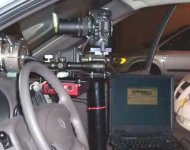1/14/2009
Extreme Weather Defeats Speed CamerasLegal challenge mounted to the use of speed cameras in extreme high and low temperatures.

Questions are being raised about the reliability of speed cameras in extreme weather conditions are being raised as temperatures drop across the globe. Parts of Minnesota, for example, saw lows of -37 degrees Fahrenheit while residents of some areas in North Dakota and Maine braved -8 degree temperatures. A Dutch lawyer is now using a recent cold snap in Amsterdam as the basis for a legal challenge, arguing that any ticket issued outside of the certified temperature range is invalid.
In exploring the issue, the Dutch newspaper De Telegraaf cited Dutch Meetinstituut (NMi) Senior Product Manager David Stam who explained that fixed speed cameras have sensors that turn off sensitive electronic components when temperatures become too hot or too cold. Stam's contention is confirmed by a 2007 incident in Finnish Lapland where speed cameras were literally frozen in place, unable to issue citations, as temperatures reached -25 degrees Fahrenheit. Despite the frigid climate, officials had not installed heating units in the devices. Nevertheless, NMi, which relies on government contracts, quickly distanced itself from De Telegraaf's account the next and said it tests equipment in all conditions.
"It is possible, for example, that equipment is protected at lower temperatures by heating units," the NMi press release stated.
US speed camera and red light camera equipment is also affected by temperature swings. While some components boast recommended operating temperatures as low as -4 to -13 degrees Fahrenheit, such as the radar units manufactured by AGD and used by Redflex speed vans, others are less tolerant of cold weather. Brochures for the Australian company's laser-based mobile speed camera product list an operating temperature range of 32 to 122 Fahrenheit.
The camera vendors themselves have bickered about the heat tolerance of rival systems. Lasercraft, for example, cleverly distanced itself from the Nikon DX2 camera used by American Traffic Solutions (ATS) when trying, unsuccessfully, to land a red light camera contract in Florida.
"Most importantly, the camera referenced (Nikon) is not the camera system used by Lasercraft, therefore eliminating this argument that Lasercraft camera systems may not operate properly in varying temperatures," Lasercraft wrote to officials in the city of Orlando.
Nikon lists a maximum operating temperature of 104 degrees and a low of just 32 for its DX2 model cameras. ATS insists these attacks are absurd. Although the temperature in a parked car in Arizona can easily exceed 120 degrees on a hot day, the ATS speed camera vans can constantly run their motor to provide air conditioning.
"The cameras have been aggressively tested for humidity in Houston and Southeast Asia, for searing heat in the Arizona desert, and in sub-zero temperatures in Calgary, Alberta Canada," ATS explains in its sales material.
In 2007, a UK motorist asked the Avon and Somerset Speed Camera Partnership for any documentation regarding the operating temperatures in which the area's speed cameras were certified to operate. Officials responded that they did not know the answer.


